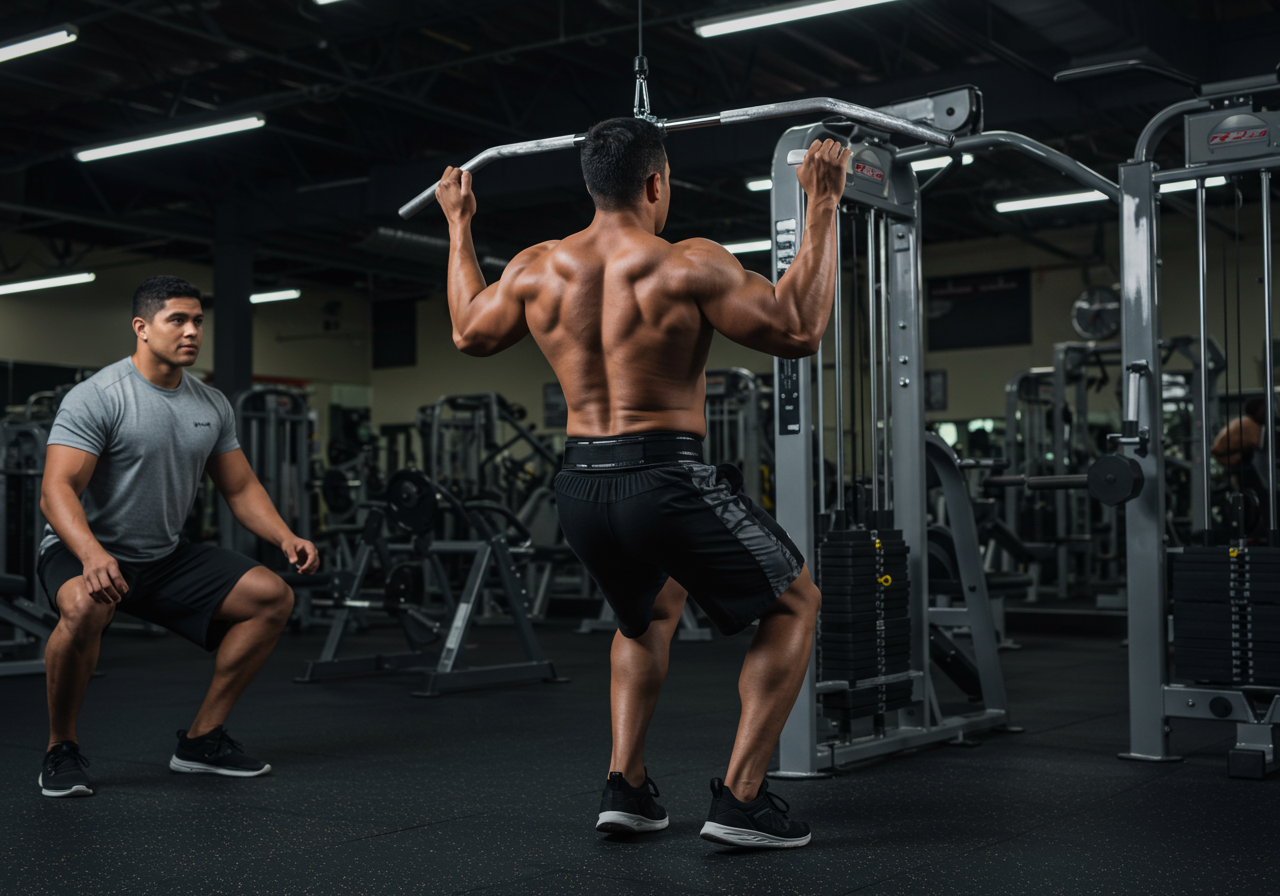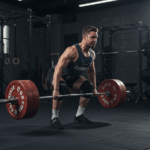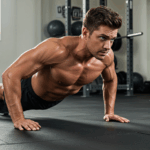Back-Width System: Why Lat Pulldowns Lead

Build a complete back-width plan around the lat pulldown
The lat pulldown targets latissimus dorsi fibers directly. Wider lats create a dramatic V-taper look.
I program pulldowns as the primary vertical pull. I pair them with rows for thickness.
Beginners learn control here. Intermediates push volume. Advanced lifters chase precise tension.
Key principles:
- Lats pull the arm down and in. Follow fiber direction.
- Scapular depression means pulling shoulders down. It protects shoulders.
- Elbows travel in front of ribs slightly. Avoid extreme flaring.
- Medium grip builds width efficiently. Ultra wide often wastes range.
- RIR means reps in reserve. Stop with 1–3 reps left.
| Block | Exercise | Sets x Reps | Rest |
|---|---|---|---|
| Warm-up | 5–8 min bike, band pull-aparts | 2 x 15 | 30–45s |
| Skill/Prime | Scap pulldowns, tempo holds | 2 x 10 slow | 60s |
| Main Lift | Lat Pulldown (medium grip) | 4 x 8–12, 1–2 RIR | 90–120s |
| Assistance | Chest-supported row, face pulls, curls | 3 x 10–15 each | 60–90s |
Quick win: Add one pulldown back-off set. Use a 3–1–1 tempo. Chase deep stretch.
Avoid yanking the bar past the chest. Stop at upper chest. Keep ribs down.
This structure supports the full body. Rows balance shoulders. Core stays braced for safety.
Technique, Cues, and Smart Variations

Use precise technique to target lats and protect joints
Set the thigh pad snug. Lock hips down. Plant feet.
Grip just outside shoulders. Wrap thumbs. Keep wrists neutral.
Start with shoulders down. Think armpits to back pockets.
Pull elbows toward rib line. Keep chest tall, but avoid over-arching.
Pause one second at the chest. Control the return fully.
Execution cues that work: Exhale as you pull. Inhale as you rise. Drive elbows, not hands.
| Attachment/Grip | Primary Feel | Joint Stress | Best Use |
|---|---|---|---|
| Straight bar, medium | Balanced lat tension | Low | All levels |
| Neutral V-bar | Heavier loads, elbow comfort | Very low | Beginners, tender elbows |
| MAG-style medium | Huge lat stretch | Low–moderate | Intermediate |
| Single-handle | Unilateral focus, stability | Low | Imbalances, advanced feel |
Drill: Do 2 sets of scap pulldowns. Move only shoulder blades. Then perform your working sets.
Avoid behind-the-neck pulldowns. They strain shoulders and neck. Use front pulldowns instead.
Beginners use neutral grips first. Intermediates use medium bars. Advanced alternate angles weekly.
Progression: Loads, Reps, and Weekly Planning

Progress steadily with clear targets and simple metrics
I track loads, reps, and RIR every session. Simple data drives gains.
Garmin or Fitbit tracks heart rate in warm-ups. I stay in Zone 2.
Use double progression. Add reps first. Then add small load jumps.
| Level | Prescription | Goal |
|---|---|---|
| Beginner | 3 x 10–12, 2–3 RIR, add 1 rep weekly | Form, control |
| Intermediate | 4 x 8–12, 1–2 RIR, add 2.5 kg when capped | Volume, tension |
| Advanced | 5 x 6–10, 0–1 RIR, periodize tempo | Peak strength, density |
| Day | Focus | Key Lifts |
|---|---|---|
| Pull | Back width + biceps | Pulldown, chest row, curls |
| Push | Chest, delts, triceps | Bench, incline, pushdowns |
| Legs | Quads, glutes | Squat, RDL, calf raises |
My session data: 60 minutes. Warm-up bike 8 minutes, 120–130 bpm. Pulldown 4 x 10 at 65 kg, 2 RIR.
I progressed to 75 kg for 8 reps in four weeks. Form stayed crisp.
Finish with 6 minutes intervals. I use 30/30s at Zone 4. Conditioning improves.
If elbows ache, switch to neutral grips. Lower volume for one week.
Recovery, Fueling, and Mobility for Lat Growth

Recover smarter to grow wider lats safely
Muscle grows when recovery matches training. Sleep and protein matter most.
I set calories by goal. I monitor with MyFitnessPal.
Simple nutrition targets:
- Protein: 1.6–2.2 g per kg body weight daily.
- Calories: slight surplus for growth. 200–300 kcal above maintenance.
- Carbs: center around training. 1–1.5 g per kg pre/post.
- Creatine monohydrate: 3–5 g daily. Safe and effective.
| Recovery Item | Target | Tool |
|---|---|---|
| Sleep | 7.5–9 hours nightly | Wind-down alarm, dark room |
| Calories | +200–300 kcal for growth | MyFitnessPal |
| Heart rate | Zone 2 warm-ups | Garmin or Fitbit |
Ten-minute mobility: Foam roll lats 2 minutes each. Hanging 2 x 30s. T-spine openers 2 x 10.
I once skipped warm-up. My biceps tendon flared for a week. I learned my lesson.
Pain in the front shoulder means stop. Reduce load. Use neutral grip and partial range until calm.
Nutrition and mobility support pulldown progress. You lift hard. Then you recover harder.
Proof, Troubleshooting, and Coaching Lessons

Validate results and refine methods for long-term result interpretation
Data and photos prove progress. Feel matters, but numbers guide choices.
My 8-week results: Pulldown top set rose from 60 kg x 8 to 75 kg x 8.
Back width improved visually. Shirts fit tighter in lats. Waist stayed similar.
Client outcomes:
- Jess, beginner: From 35 kg x 12 to 47.5 kg x 12 in 6 weeks.
- Quote: “My posture feels open. My shoulders relax during work.”
- Sam, intermediate: Lost 3.8 kg fat in 8 weeks. V-taper visible.
- Quote: “Neutral grip saved my elbows. My pull feels locked in.”
| Week | Top Set Load | Reps | RIR | Note |
|---|---|---|---|---|
| 1 | 60 kg | 8 | 2 | Learning tempo |
| 4 | 70 kg | 9 | 1 | Grip switch helped |
| 8 | 75 kg | 8 | 1 | Elbows healthy |
Immediate checks: Film one set weekly. Track load, reps, RIR, and elbow comfort. Compare photos monthly.
Cardio comparison with clients: HIIT beat steady-state for fat loss. Definition improved faster.
Example: Two weekly HIIT sessions cut 1.2% body fat in 6 weeks. Steady-state cut 0.7%.
Plateau signs: Stagnant reps for three weeks, rising joint pain, poor sleep. Deload one week.
Troubleshooting steps: Reduce volume 20%. Use neutral grip. Add tempo. Improve sleep by 30 minutes.
Motivation dip fix: Shorten sessions to 35 minutes. Keep the main set. Win the day.
This system grows width, protects joints, and fits real schedules. Stay consistent and measure.






